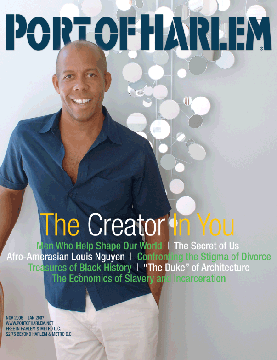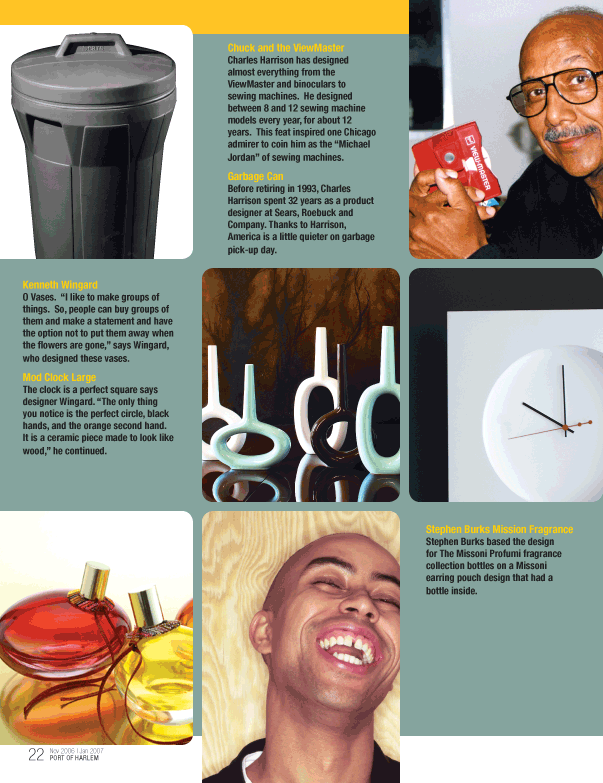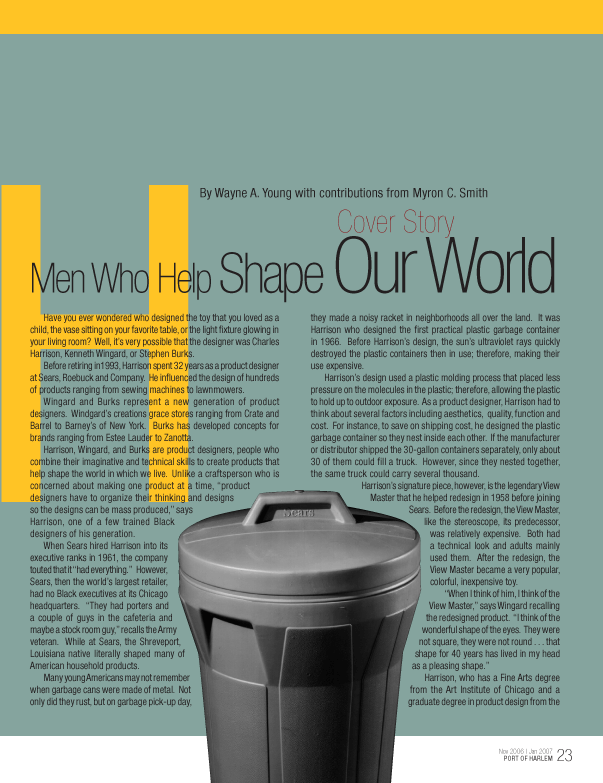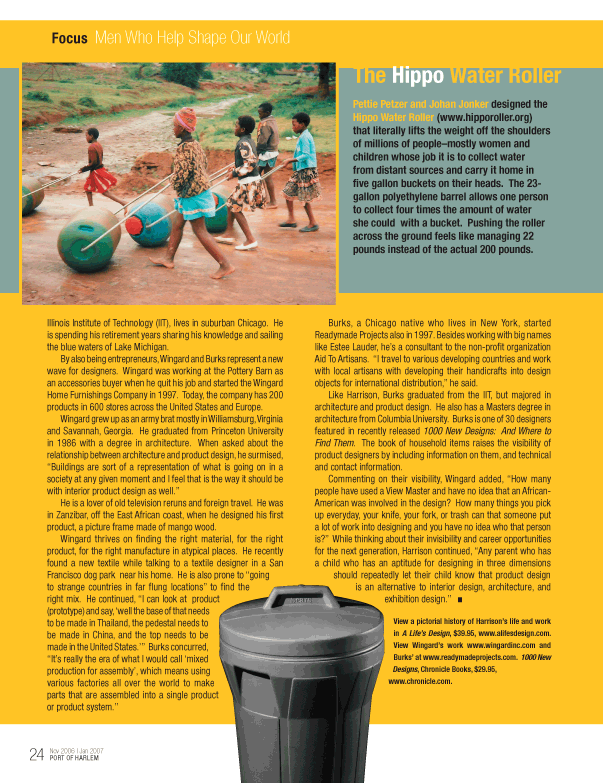COVER STORY
22 Men Who Help Shape Our World
Product Designer Ken Wingard pictured with his mirrored Op Art from his latest collection. His company makes the wall
sculpture from floating mirrors. The mirrors capture and reflect items in a room creating a living piece of art that changes with the day.
Interviews with product designers Charles Harrison, Kenneth Wingard and Stephen Burks, men who combine their imaginative and technical skills to create products that help shape the world in which we live.
FOCUS:
The Creator in You
25 Vase or Sculptural Vessel?
25 From Marriage to Clowning
26 In the Woodshop
26 Sleeping on the Wall
FEATURE:
28 Surviving Twice: An Amerasian Child of the Vietnam War
DEPARTMENTS
2 LETTERS TO THE EDITOR
THE PUBLISHER’S POINT
5 The Next Decade
PRAISING THE PAST
6 King Solomon “Sol” White
THE OTHER SIDE
7 Black Gold: The Economics of Slavery and Incarceration
The Creator in You - Interview with
Charles Harrison, Kenneth Wingard, and Stephen Burks

On The Dock
IN FASHION
Jewelry Designer Charles
MONEY MATTERS
10 The Secret of Us: How Black Businesses Survive
OUR SPACE
12 Paul Revere Williams, “The Duke” of Architecture
TRAVEL STORY
14 Zanzibar: Paradise on a Budget
HEALTH
16 Dental Implants
18 Getting It Right This Time: Confronting the Stigma of Divorce
ENTERTAINMENT
29 The Proud Family Returns
RECIPE
30 Red Rice
BOOK REVIEW
31 Legacy: Treasures of Black History
COMING UP
32 Sugarloaf Crafts Festival, Black Doll Show, BZB Black Gifts Show and more
Jewelry Designer Charles
MONEY MATTERS
10 The Secret of Us: How Black Businesses Survive
OUR SPACE
12 Paul Revere Williams, “The Duke” of Architecture
TRAVEL STORY
14 Zanzibar: Paradise on a Budget
HEALTH
16 Dental Implants
18 Getting It Right This Time: Confronting the Stigma of Divorce
ENTERTAINMENT
29 The Proud Family Returns
RECIPE
30 Red Rice
BOOK REVIEW
31 Legacy: Treasures of Black History
COMING UP
32 Sugarloaf Crafts Festival, Black Doll Show, BZB Black Gifts Show and more
;
;
;
Have you ever wondered who designed the toy that you loved as a child, the vase sitting on your favorite table, or the light fixture glowing in your living room? Well, it’s very possible that the designer was Charles Harrison, Kenneth Wingard, or Stephen Burks.
Before retiring in1993, Harrison spent 32 years as a product designer at Sears, Roebuck and Company. He influenced the design of hundreds of products ranging from sewing machines to lawnmowers.
Wingard and Burks represent a new generation of product designers. Windgard’s creations grace stores ranging from Crate and Barrel to Barney’s of New York. Burks has developed concepts for brands ranging from Estee Lauder to Zanotta.
Harrison, Wingard, and Burks are product designers, people who combine their imaginative and technical skills to create products that help shape the world in which we live.
Unlike a craftsperson who is concerned about making one product at a time, “product designers have to organize their thinking and designs so the designs can be mass produced,” says Harrison, one of a few trained Black designers of his generation.
When Sears hired Harrison into its executive ranks in 1961, the company touted that it “had everything.” However, Sears, then the world’s largest retailer, had no Black executives at its Chicago headquarters. “They had porters and a couple of guys in the cafeteria and maybe a stock room guy,” recalls the Army veteran. While at Sears, the Shreveport, Louisiana native literally shaped many of American household products.
Many young Americans may not remember when garbage cans were made of metal. Not only did they rust, but on garbage pick-up day, they made a noisy racket in neighborhoods all over the land. It was Harrison who designed the first practical plastic garbage container in 1966.
Before Harrison’s design, the sun’s ultraviolet rays quickly destroyed the plastic containers then in use; therefore, making their use expensive. Harrison’s design used a plastic molding process that placed less pressure on the molecules in the plastic; therefore, allowing the plastic to hold up to outdoor exposure.
As a product designer, Harrison had to think about several factors including aesthetics, quality, function and cost. For instance, to save on shipping cost, he designed the plastic garbage container so they nest inside each other. If the manufacturer or distributor shipped the 30-gallon containers separately, only about 30 of them could fill a truck. However, since they nested together, the same truck could carry several thousand.
Harrison’s signature piece, however, is the legendary View Master that he helped redesign in 1958 before joining Sears. Before the redesign, the View Master, like the stereoscope, its predecessor, was relatively expensive. Both had a technical look and adults mainly used them. After the redesign, the View Master became a very popular, colorful, inexpensive toy.
“When I think of him, I think of the View Master,” says Wingard recalling the redesigned product. “I think of the wonderful shape of the eyes. They were not square, they were not round . . . that shape for 40 years has lived in my head as a pleasing shape.”
Harrison, who has a Fine Arts degree from the Art Institute of Chicago and a graduate degree in product design from the Illinois Institute of Technology (IIT), lives in suburban Chicago. He is spending his retirement years sharing his knowledge and sailing the blue waters of Lake Michigan.
Before retiring in1993, Harrison spent 32 years as a product designer at Sears, Roebuck and Company. He influenced the design of hundreds of products ranging from sewing machines to lawnmowers.
Wingard and Burks represent a new generation of product designers. Windgard’s creations grace stores ranging from Crate and Barrel to Barney’s of New York. Burks has developed concepts for brands ranging from Estee Lauder to Zanotta.
Harrison, Wingard, and Burks are product designers, people who combine their imaginative and technical skills to create products that help shape the world in which we live.
Unlike a craftsperson who is concerned about making one product at a time, “product designers have to organize their thinking and designs so the designs can be mass produced,” says Harrison, one of a few trained Black designers of his generation.
When Sears hired Harrison into its executive ranks in 1961, the company touted that it “had everything.” However, Sears, then the world’s largest retailer, had no Black executives at its Chicago headquarters. “They had porters and a couple of guys in the cafeteria and maybe a stock room guy,” recalls the Army veteran. While at Sears, the Shreveport, Louisiana native literally shaped many of American household products.
Many young Americans may not remember when garbage cans were made of metal. Not only did they rust, but on garbage pick-up day, they made a noisy racket in neighborhoods all over the land. It was Harrison who designed the first practical plastic garbage container in 1966.
Before Harrison’s design, the sun’s ultraviolet rays quickly destroyed the plastic containers then in use; therefore, making their use expensive. Harrison’s design used a plastic molding process that placed less pressure on the molecules in the plastic; therefore, allowing the plastic to hold up to outdoor exposure.
As a product designer, Harrison had to think about several factors including aesthetics, quality, function and cost. For instance, to save on shipping cost, he designed the plastic garbage container so they nest inside each other. If the manufacturer or distributor shipped the 30-gallon containers separately, only about 30 of them could fill a truck. However, since they nested together, the same truck could carry several thousand.
Harrison’s signature piece, however, is the legendary View Master that he helped redesign in 1958 before joining Sears. Before the redesign, the View Master, like the stereoscope, its predecessor, was relatively expensive. Both had a technical look and adults mainly used them. After the redesign, the View Master became a very popular, colorful, inexpensive toy.
“When I think of him, I think of the View Master,” says Wingard recalling the redesigned product. “I think of the wonderful shape of the eyes. They were not square, they were not round . . . that shape for 40 years has lived in my head as a pleasing shape.”
Harrison, who has a Fine Arts degree from the Art Institute of Chicago and a graduate degree in product design from the Illinois Institute of Technology (IIT), lives in suburban Chicago. He is spending his retirement years sharing his knowledge and sailing the blue waters of Lake Michigan.
By also being entrepreneurs, Wingard and Burks represent a new wave for designers. Wingard was working at the Pottery Barn as an accessories buyer when he quit his job and started the Wingard Home Furnishings Company in 1997. Today, the company has 200 products in 600 stores across the United States and Europe.
Wingard grew up as an army brat mostly in Williamsburg, Virginia and Savannah, Georgia. He graduated from Princeton University in 1986 with a degree in architecture. When asked about the relationship between architecture and product design, he surmised, “Buildings are sort of a representation of what is going on in a society at any given moment and I feel that is the way it should be with interior product design as well.”
He is a lover of old television reruns and foreign travel. He was in Zanzibar, off the East African coast, when he designed his first product, a picture frame made of mango wood.
Wingard thrives on finding the right material, for the right product, for the right manufacture in atypical places. He recently found a new textile while talking to a textile designer in a San Francisco dog park that is near his home.
He is also prone to “going to strange countries in far flung locations” to find the right mix. He continued, “I can look at product (prototype) and say, ‘well the base of that needs to be made in Thailand, the pedestal needs to be made in China, and the top needs to be made in the United States.’” Burks concurred, “It's really the era of what I would call 'mixed production for assembly', which means using various factories all over the world to make parts that are assembled into a single product or product system.”
Burks, a Chicago native who lives in New York, started Readymade Projects also in 1997. Besides working with big names like Estee Lauder, he’s a consultant to the non-profit organization Aid To Artisans. “I travel to various developing countries and work with local artisans with developing their handicrafts into design objects for international distribution,” he said.
Like Harrison, Burks graduated from the IIT, but majored in architecture and product design. He also has a Masters degree in architecture from Columbia University. Burks is one of 30 designers featured in recently released "1000 New Designs: And Where to Find Them." The book of household items raises the visibility of product designers by including information on them, and technical and contact information.
Commenting on their visibility, Wingard added, “How many people have used a View Master and have no idea that an African-American was involved in the design? How many things you pick up everyday, your knife, your fork, or trash can that someone put a lot of work into designing and you have no idea who that person is?” While thinking about their invisibility and career opportunities for the next generation, Harrison continued, “Any parent who has a child who has an aptitude for designing in three dimensions should repeatedly let their child know that product design is an alternative to interior design, architecture, and exhibition design.”
View a pictorial history of Harrison’s life and work in "A Life’s Design," $39.95. View Wingard’s work and Burks’work. 1000 New Designs, Chronicle Books, $29.95.
Wingard grew up as an army brat mostly in Williamsburg, Virginia and Savannah, Georgia. He graduated from Princeton University in 1986 with a degree in architecture. When asked about the relationship between architecture and product design, he surmised, “Buildings are sort of a representation of what is going on in a society at any given moment and I feel that is the way it should be with interior product design as well.”
He is a lover of old television reruns and foreign travel. He was in Zanzibar, off the East African coast, when he designed his first product, a picture frame made of mango wood.
Wingard thrives on finding the right material, for the right product, for the right manufacture in atypical places. He recently found a new textile while talking to a textile designer in a San Francisco dog park that is near his home.
He is also prone to “going to strange countries in far flung locations” to find the right mix. He continued, “I can look at product (prototype) and say, ‘well the base of that needs to be made in Thailand, the pedestal needs to be made in China, and the top needs to be made in the United States.’” Burks concurred, “It's really the era of what I would call 'mixed production for assembly', which means using various factories all over the world to make parts that are assembled into a single product or product system.”
Burks, a Chicago native who lives in New York, started Readymade Projects also in 1997. Besides working with big names like Estee Lauder, he’s a consultant to the non-profit organization Aid To Artisans. “I travel to various developing countries and work with local artisans with developing their handicrafts into design objects for international distribution,” he said.
Like Harrison, Burks graduated from the IIT, but majored in architecture and product design. He also has a Masters degree in architecture from Columbia University. Burks is one of 30 designers featured in recently released "1000 New Designs: And Where to Find Them." The book of household items raises the visibility of product designers by including information on them, and technical and contact information.
Commenting on their visibility, Wingard added, “How many people have used a View Master and have no idea that an African-American was involved in the design? How many things you pick up everyday, your knife, your fork, or trash can that someone put a lot of work into designing and you have no idea who that person is?” While thinking about their invisibility and career opportunities for the next generation, Harrison continued, “Any parent who has a child who has an aptitude for designing in three dimensions should repeatedly let their child know that product design is an alternative to interior design, architecture, and exhibition design.”
View a pictorial history of Harrison’s life and work in "A Life’s Design," $39.95. View Wingard’s work and Burks’work. 1000 New Designs, Chronicle Books, $29.95.
This is the Same Cover Story, but in its Original Layout



Advertisers | Contact Us | Events | Links | Media Kit | Our Company | Payments Pier
Press Room | Print Cover Stories Archives | Electronic Issues and Talk Radio Archives | Writer's Guidelines




